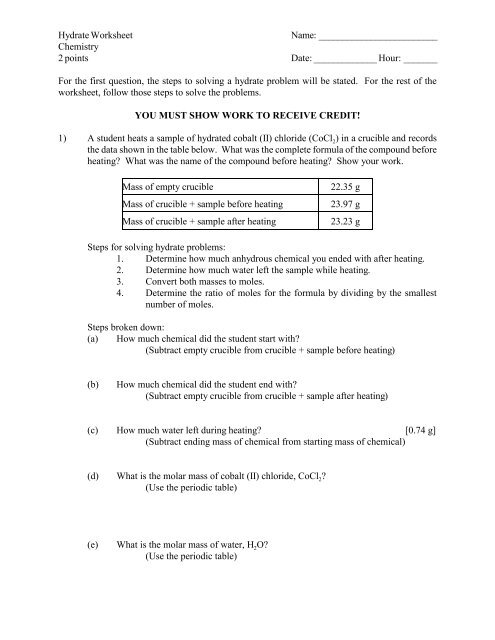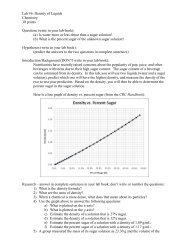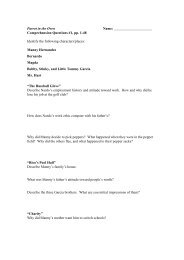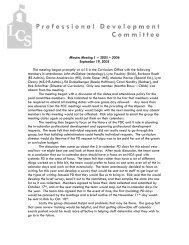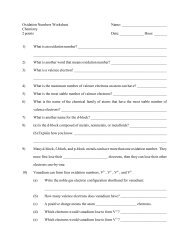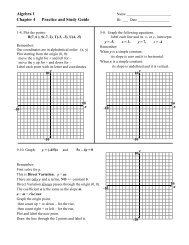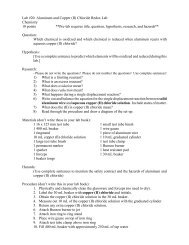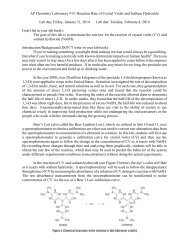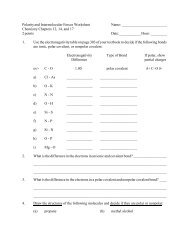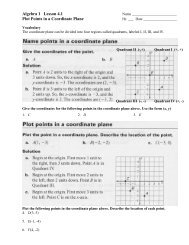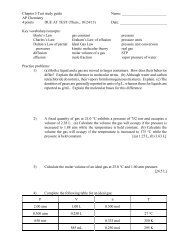P:\MyFiles\Chemistry\Chem Chapter 08\Hydrate-Empirical Formula ...
P:\MyFiles\Chemistry\Chem Chapter 08\Hydrate-Empirical Formula ...
P:\MyFiles\Chemistry\Chem Chapter 08\Hydrate-Empirical Formula ...
You also want an ePaper? Increase the reach of your titles
YUMPU automatically turns print PDFs into web optimized ePapers that Google loves.
Hydrate WorksheetName: _________________________Chemistry2 points Date: _____________ Hour: _______For the first question, the steps to solving a hydrate problem will be stated. For the rest of theworksheet, follow those steps to solve the problems.YOU MUST SHOW WORK TO RECEIVE CREDIT!1) A student heats a sample of hydrated cobalt (II) chloride (CoCl 2 ) in a crucible and recordsthe data shown in the table below. What was the complete formula of the compound beforeheating? What was the name of the compound before heating? Show your work.Mass of empty crucibleMass of crucible + sample before heatingMass of crucible + sample after heating22.35 g23.97 g23.23 gSteps for solving hydrate problems:1. Determine how much anhydrous chemical you ended with after heating.2. Determine how much water left the sample while heating.3. Convert both masses to moles.4. Determine the ratio of moles for the formula by dividing by the smallestnumber of moles.Steps broken down:(a) How much chemical did the student start with?(Subtract empty crucible from crucible + sample before heating)(b)How much chemical did the student end with?(Subtract empty crucible from crucible + sample after heating)(c) How much water left during heating? [0.74 g](Subtract ending mass of chemical from starting mass of chemical)(d) What is the molar mass of cobalt (II) chloride, CoCl 2 ?(Use the periodic table)(e) What is the molar mass of water, H 2 O?(Use the periodic table)
(f)Convert your ending mass of chemical (from question b above) to moles using themolar mass of cobalt (II) chloride (from question d above):(g)Convert your mass of water lost (from question c above) to moles using the molarmass of water (from question e above):(h)Divide by the smallest number of moles (either your answer in question f or inquestion g) to determine the ratio for the formula. (Round to the nearest wholenumber.)(i) Write the final formula: CoCl 2 · _____ H 2 ONow try one on your own. Follow the same steps!2) A student heated a sample of hydrated magnesium iodide (MgI 2 ) in a crucible and recordedthe data shown in the table below. What was the complete formula of the compound beforeheating? What was the name of the compound before heating? Show your work.Mass of empty crucibleMass of crucible + sample before heatingMass of crucible + sample after heating19.21 g34.74 g29.44 g


